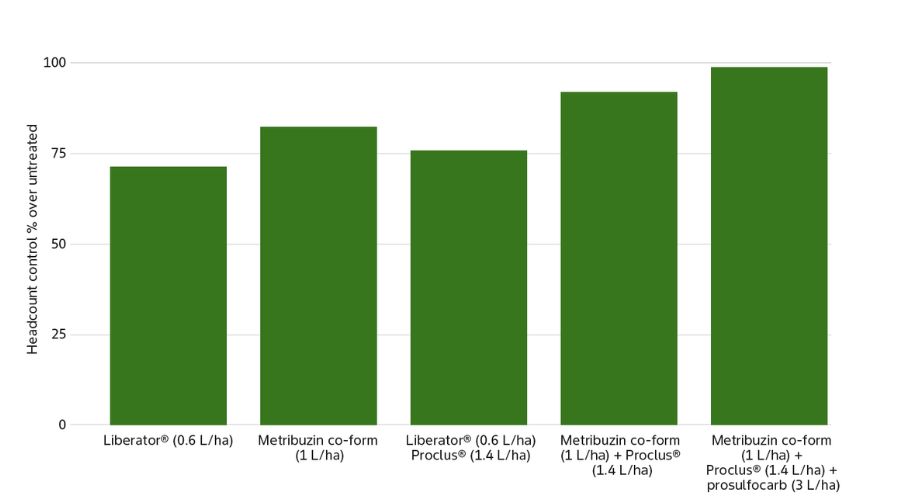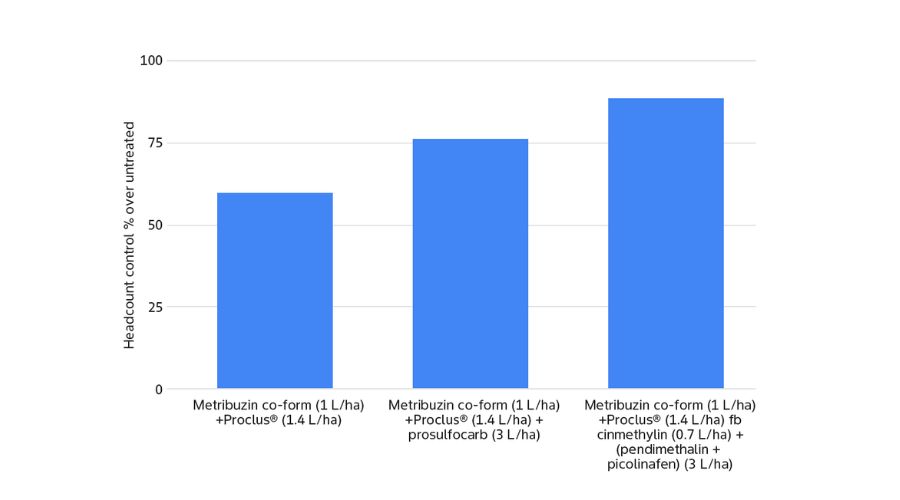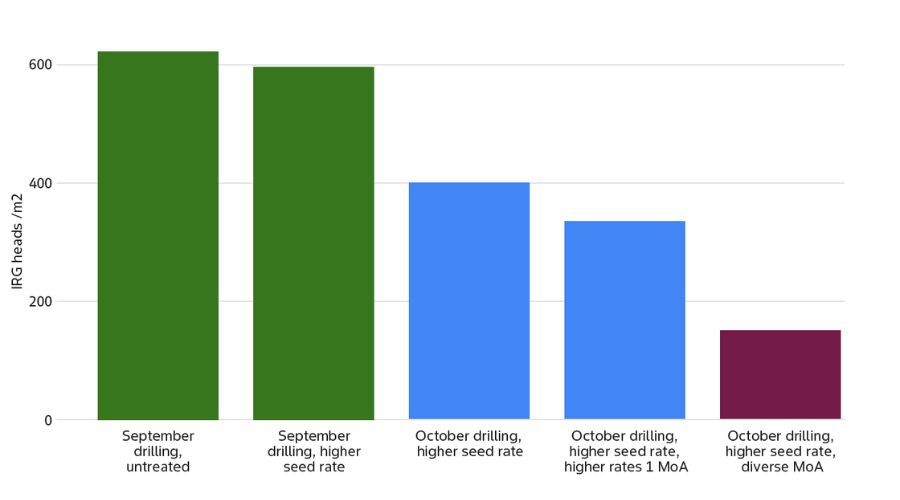Bayer: Weed out uncertainty with a diverse herbicide programme
21st July 2025
Stop serious weed infestations to get the best return from winter wheat. Black-grass, Italian ryegrass, brome, and many other weeds rob yield by using light, water and nutrition destined for the crop.

Rachel Banks, technical manager at Bayer, recommends a diverse herbicide programme to maximise control.
Effective integrated weed management starts with cultural controls to reduce the size of the weed seedbank. But once the crop is drilled, the herbicide programme takes centre stage with residual herbicides at pre-em and follow-up applications.
Diversity is key. Use different actives within the programme to improve control and manage resistance.
Each active is unique. Factor in the mode of action (MoA), root or shoot activity, and longevity to make a balanced herbicide programme that copes with variable conditions and delivers high levels of control.
Strong start to the programme
An effective pre-em sets the standard for the season, so it’s important to start strong.
Metribuzin co-forms like Alternator® Met, Octavian® Met and Cadou® Met contain three different MoAs with root and shoot activity. Including Proclus® adds a fourth MoA to improve control and increase longevity in the programme.
Also, it is less reliant on soil moisture for efficacy than many other actives, so it will be even more valuable this autumn if dry conditions continue.
This combination of proven herbicides offers excellent control of black-grass, Italian ryegrass and brome species with the flexibility to follow up with more chemistry in the toughest situations.
Graph 1: Excellent Italian ryegrass control

Graph 2: Good black-grass control – use in a tight sequence with other chemistry for maximum effect

Root or shoot activity
The most effective herbicide programmes have a combination of root and shoot activity to attack weeds in different ways.
Herbicides like flufenacet, metribuzin and cinmethylin are more soluble and move through the soil for uptake by the roots of germinating weeds. Make sure there is sufficient soil moisture and a good quality seedbed without impermeable barriers for these actives to perform at their best.
Proclus® and diflufenican are not mobile – they remain at the soil surface. Weeds take in these herbicides as the shoots emerge out of the soil.
Less reliant on soil moisture for efficacy, aim for consistent coverage across the field to form a protective layer on the surface. A fine, firm seedbed free of clods helps with this.
Protection throughout autumn
The pre-em controls weeds which germinate due to disturbance from drilling. But further germination is a problem too, earlier drilled crops and Italian ryegrass are situations where continued protection is very important.
Each active degrades at a different rate so it controls germinating weeds for different lengths of time. Be sure to include herbicides with good longevity like Proclus® in the programme.
In general, all actives degrade more quickly in warm and moist conditions. Herbicides applied later in autumn, after delayed drilling for example, have better longevity because of cooler weather.
Topping up is another way to build in more protection. A second or even third herbicide application controls subsequent weed germination. If expecting protracted germination of Italian ryegrass, plan to come back 2–4 weeks after the pre-em.
For black-grass, we normally recommend a short gap of 1–2 weeks for any follow up spray because black-grass germination is far more concentrated around early/mid-October.
What is a MoA?
The MoA is the chemical basis for how a herbicide kills a weed. Different herbicides can have the same MoA. For example, prosulfocarb, tri-allate and flufenacet all inhibit cells from making very long-chain fatty acids, disrupting cell division. They’re all in the Herbicide Resistance Action Committee (HRAC) Group 15.
In contrast, diflufenican is in Group 12 as it inhibits an enzyme phytoene desaturase, which is important in photosynthesis.
For autumn, there are six different MoAs available for the residual programme; HRAC Groups 3, 5, 12, 15, 30, 32. Growers can also use contact-acting chemistry after weed emergence, Atlantis® OD contains mesosulfuron + iodosulfuron, both from HRAC Group 2.
For resistance management, use actives from different HRAC MoA groups and avoid using any active in the programme more than once.
How MoA diversity improves control
Bayer has done trials in conjunction with NIAB to measure the benefit of more MoAs in the programme. Normally trials look at products at full rate, which is how farmers use them and what we generally recommend for resistance management.
But these trials don’t easily show if control is thanks to diverse MoA or just the effect of applying more herbicide in total. The trial with NIAB was designed to split out these two variables.
Two years of trials showed that MoA diversity improved efficacy. The effect was more pronounced in Italian ryegrass than black-grass.
In practical terms it means that mode of action diversity is not just about long-term stewardship but about better short-term control too. In addition to chemical controls, cultural controls also stack together to increase efficacy.
The starting point was an untreated September drilled crop. Next, higher seed rates were tested, then October drilling and higher seed rates.
Shifting to October drilling had a huge impact on overall control. On top of cultural controls, a single active programme was compared to diverse modes of action. Control from the diverse programme was far superior.
Graph 3: Stacking controls for Italian rye-grass control

Broadleaf weeds
Check broadleaf weed activity of specific herbicides to match the problem in your field.
A metribuzin co-form like Alternator® Met, Octavian® Met and Cadou® Met + Proclus® has activity on some of the most serious broadleaf weeds including cleavers, groundsel and mayweed.
| Proclus | Alternator® Met / Octavian® Met / Cadou® Met | |
| Charlock | Field Pansy | Field Forget-me-not |
| Chickweed | Bur Chervil | Field Mouse Ear |
| Cleavers | Charlock | Field Pansy |
| Volunteer OSR | Chickweed | Groundsel |
| Speedwell, C.F. | Cleavers | Mayweed |
| Common Poppy | Common field speedwell | Red/Henbit Dead- nettle |
| Mayweed | Common Poppy | Shepherd’s Purse |
| Red Dead-nettle | Corn Spurry | Volunteer OSR |
| Shepherd’s Purse | Cranesbill | Wild Radish (Runch) |
Safe application – best practice
Root-acting herbicides can affect crops too. Drilling depth and quality is very important to keep herbicides away from crop roots.
- Drill to at least 32mm
- Closed slots with no exposed seed
- Avoid applications when heavy rain is forecast
- Be cautious on lighter soils
- Sequences are safer than large tank-mixes.
Alternator® Met contains metribuzin, flufenacet and diflufenican.
Atlantis® OD contains mesosulfuron and iodosulfuron.
Cadou® Met contains flufenacet, diflufenican and metribuzin.
Liberator® contains flufenacet and diflufenican.
Octavian® Met contains metribuzin, flufenacet and diflufenican.
Proclus® contains aclonifen.
Alternator®, Atlantis®, Cadou®, Octavian®, Proclus® and Liberator® are Registered Trademarks of Bayer.
All other brand names used are Trademarks of other manufacturers in which proprietary rights may exist. Use plant protection products safely. Always read the label and product information before use. Pay attention to the risk indications and follow the safety precautions on the label. For further information, including contact details, visit the Bayer website or call 0808 1969522.
Read more arable news.
08
